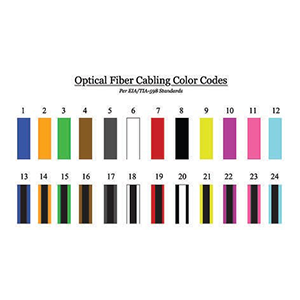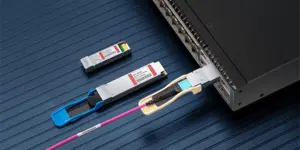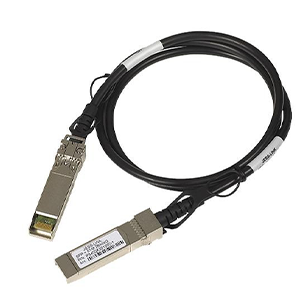In the era of modern technological development, fiber optic patch cords play an important role in achieving high-speed data transmission and reliable network connections. As a fiber optic cable used to connect fiber optic equipment and connectors, fiber optic jumper cables realize the connection of fiber optic networks through optical signal transmission.
Whether it is in the fields of data centers, communication networks, video and audio transmission, or test and measurement, fiber optic patch cords play an important role. This article will delve into the applications and advantages of fiber optic patch cords and introduce their specific application cases in different fields, allowing you to better understand the importance and value of fiber optic patch cords.
Definition and principle of optical fiber patch cord
- What is a fiber optic patch cable:
Optical Fiber Patch Cable, also known as fiber optic jumper, fiber optic patch cord or fiber optic cable, is a short-distance fiber optic cable used to connect fiber optic equipment. It is commonly used in fiber optic communications systems, data centers, computer networks, and other applications that require high-speed fiber optic connections.
Fiber optic jumper cables are composed of optical fiber core wires and protective layers. They usually use Single-Mode Fiber, SMF or Multi-Mode Fiber, MMF with a smaller diameter. These optical fiber core wires are connected to the optical fiber port of the device through special optical fiber connectors (such as SC, LC, ST, etc.) to realize the transmission of optical signals.
- Working principle of fiber optic patch cord:
-
Optical signal transmission: One end of the optical fiber jumper is connected to the optical fiber transmitting device, such as an optical fiber switch or optical fiber transmission equipment. When a device sends an optical signal, the optical signal is converted into light pulses and transmitted through the core of the fiber optic patch cord.
-
Fiber optic transmission: Optical signals are transmitted through the core of fiber optic patch cords. Optical fiber jumpers usually use single mode fiber (Single Mode Fiber, SMF) or multimode fiber (Multimode Fiber, MMF). During the transmission process, the optical signal propagates through the phenomenon of total reflection inside the optical fiber.
-
Optical signal reception: The other end of the fiber optic jumper is connected to the fiber optic receiving device, such as a fiber optic transceiver or fiber optic receiving module. When the optical signal reaches the receiving end, the optical fiber receiving equipment converts the optical signal into an electrical signal for subsequent processing and use.
-
Fiber optic connectors: Both ends of the fiber optic jumper are equipped with fiber optic connectors, such as SC, LC, ST and other types of connectors. These connectors are precisely designed and assembled to ensure proper alignment and connection of optical fibers to minimize loss and reflection of optical signals.
Fiber patch cord data center application
-
Data center interconnection: Data centers usually include multiple servers, storage devices and network devices. Fiber optic jumpers are used to connect these devices to build a high-speed, reliable data communication network. Through fiber optic patch cords, data centers can achieve fast communication between servers, high-speed access to storage devices, and interconnection between network devices.
-
Internal connections in the data center: There are usually a large number of equipment and cabinets inside the data center. Fiber optic jumpers are used to connect fiber switches, routers, servers, storage devices, etc. between different cabinets and equipment. Through fiber optic patch cords, high-density, high-bandwidth device connections can be achieved, providing fast data transmission and communication.
-
Fibre Channel Connection: Fiber optic jumpers are also used to connect fiber channels in data centers to connect fiber channels between different computer rooms, floors or cabinets. This enables high-speed data transmission and communication between different areas within the data center, providing better flexibility and scalability.
-
Supercomputer connections: In large-scale computing and supercomputer clusters, fiber optic patch cords are used to connect computing nodes, storage nodes, and network nodes. Through high-speed, low-latency fiber optic patch cord connections, efficient processing and data exchange of large-scale computing tasks can be achieved.
-
Virtualized environment connection: In a virtualized environment, optical fiber jumpers are used to connect virtualized servers, virtual storage devices and network devices to build a high-speed virtualized network. This can provide stable, high-bandwidth data transmission and support functions such as virtual machine migration, storage access, and network communication.
Optical fiber jumper communication network application
Fiber optic patch cords are widely used in communication network applications, providing high-speed, reliable data transmission and connections for modern communications. The following are several common uses of fiber optic patch cords in communication network applications:
-
Fiber optic broadband access: Fiber optic patch cords are used to provide broadband access services and connect users’ homes or businesses to fiber optic communication networks. Through fiber optic jumpers, users can enjoy high-speed and stable Internet access, supporting high-definition video streaming, online games, large-capacity file transfer and other needs.
-
Fiber optic metropolitan area network: Optical fiber jumpers are used to connect communication facilities within a city to build a high-speed metropolitan area network. Through optical fiber jumpers, data transmission and communication between different locations are realized, and remote office, data sharing and cloud services between enterprises are supported.
-
Fiber optic backbone network: Fiber optic jumpers are an important part of building a fiber optic backbone network. The optical fiber backbone network connects communication nodes in different cities and regions and carries a large amount of data traffic and communication services. Fiber optic patch cords provide high-speed, large-capacity data transmission capabilities in backbone networks, supporting long-distance communications and high-bandwidth requirements.
-
Data center interconnection: Optical fiber jumpers are used to connect optical fiber communication links between different data centers to achieve fast communication and data exchange between data centers. This can support data backup, disaster recovery, distributed computing and other applications, and provide high availability and efficient data center interconnection.
-
Mobile communication network: Fiber optic patch cords play an important role in mobile communication networks. They are used to connect mobile communication base stations, transmission networks and core networks to achieve high-speed and reliable transmission of mobile communication services. Fiber optic patch cords support large-capacity data transmission and low-latency communications, providing mobile communication users with high-quality voice, data and video services.
-
Fiber optic LAN: Fiber optic patch cords are used to build local area networks (LAN) to connect different devices and users to achieve high-speed, low-latency data transmission and communication. Fiber optic patch cords are widely used in local area networks in enterprises, schools, hospitals and other places to support internal communications, file sharing and multimedia applications.
Fiber optic patch cord video and audio transmission applications
Fiber optic patch cords are widely used in video and audio transmission applications and can provide high-quality, high-bandwidth transmission capabilities. Here are a few common uses for fiber optic patch cords in video and audio transmission applications:
-
HD Video Transmission: Fiber optic patch cables can be used to transmit HD video signals from cameras, video players or other video sources to devices such as displays, projectors or monitors. The high bandwidth and low loss characteristics of fiber optic patch cords ensure high definition and stability of video signals, providing an excellent visual experience whether in home entertainment systems, conference rooms, or movie theaters.
-
Remote monitoring and video conferencing: Fiber optic patch cords can be used in remote monitoring and video conferencing systems to transmit video signals from surveillance cameras or conference terminals to monitoring centers or remote conference terminals. The high bandwidth and anti-interference capabilities of fiber optic patch cords can ensure real-time transmission of video signals and high-quality conference experience.
-
Audio signal transmission: Optical fiber jumpers can be used to transmit audio signals to connect audio sources (such as music players, audio interfaces, etc.) to sound systems (such as speakers, audio receivers, etc.). The low noise and anti-interference properties of fiber optic patch cords ensure the clarity and fidelity of audio signals, providing a high-quality audio experience.
-
Broadcasting and television transmission: Optical fiber jumpers are widely used in the field of radio and television transmission, used to transmit radio and television channels, satellite signals, cable TV signals, etc. to radio and television stations or user terminals. The high bandwidth and reliability of fiber optic patch cords can meet the transmission requirements of radio and television signals and maintain signal quality and integrity.
-
Multimedia data center: In multimedia data centers, fiber optic jumpers are used to connect multimedia servers, storage devices and multimedia terminals. Through fiber optic jumpers, large-scale audio and video data transmission and processing can be achieved, supporting the storage, editing, playback and distribution of audio and video.
Fiber optic patch cord test and measurement applications
Fiber optic patch cord test and measurement applications cover fiber optic link testing, link length measurement, end-to-end performance testing, fiber optic connection quality inspection, and fiber optic patch cord marking and identification. These applications help ensure the quality, performance and connection reliability of fiber optic patch cords to provide high quality fiber optic transmission and communications.
-
Fiber optic link testing: Fiber optic patch cords are often used to test the performance and quality of fiber optic links. By using a light source and an optical power meter, it is possible to measure the optical signal transmission loss (attenuation) of the fiber patch cord as well as the reflection loss at the connection point. This helps determine the quality of the link and ensures that the optical signal remains stable and reliable during transmission.
-
Link length measurement: Link length measurement can also be performed during fiber optic patch cord testing to determine the actual length of the fiber optic patch cord. By using a Time Domain Reflectometer (OTDR) or Optical Time Domain Reflectometer (OTR), the length of a fiber optic patch cord can be determined by emitting a pulse of light and measuring the time and intensity of the reflected signal.
-
End-to-end performance testing: Fiber optic patch cords are also used to test the end-to-end performance of the entire fiber optic link. This includes measuring the link’s bandwidth, transmission delay, bit error rate (BER) and other parameters. These tests can be used to evaluate whether the link is performing as expected and to help troubleshoot any potential issues or failures.
-
Fiber optic connection quality inspection: Fiber optic patch cord testing can also be used to check the quality of fiber optic connection points. By testing insertion loss and reflection loss at a connection point, you can determine whether the connection is tight, whether the signal is transmitting properly, and identify issues with any connection points such as loose, dirty, or damaged connections.
-
Fiber optic patch cord identification and identification: In large fiber optic networks, fiber optic patch cord testing can also be used to identify and identify the physical connections between different patch cords. By performing identification and measurements on each patch cord, you can map the patch cords and ensure correct patch cord connections.
Wireless communication application of optical fiber patch cord
Fiber optic patch cords play an important role in wireless communication applications. They provide high-speed, reliable fiber optic transmission solutions to support the connection and data transmission of wireless communication systems. The following are several common uses of fiber optic patch cords in wireless communications applications:
-
Inter-base station connection: Optical fiber jumpers are used to connect communication links between different base stations to build a high-speed and stable inter-base station communication network. Transmitting data through fiber optic jumpers can provide high-bandwidth and low-latency connections, support data exchange and coordination between base stations, and improve the overall performance of the wireless network.
-
Fiber to the Antenna (FTTA): Fiber optic patch cords play a key role in Fiber to the Antenna (FTTA) architecture. They connect the optical fiber transmission system between the base station equipment and the antenna, converting wireless signals into optical signals for transmission. The FTTA architecture utilizes fiber optic patch cords to achieve long-distance transmission and flexibility, providing high-capacity and high-reliability wireless communication solutions.
-
Microwave fiber optic interface: Fiber optic patch cords can be used to connect the interface between microwave equipment and fiber optic communication networks. In microwave communication systems, fiber optic patch cords are used to convert microwave signals into optical signals and transmit them in the fiber optic network. This interface solution provides high-bandwidth, low-loss transmission, improving the performance and coverage of microwave communication systems.
-
Wireless access point connection: Fiber optic patch cords are used to connect wireless access points (such as Wi-Fi access points) to network infrastructure to achieve high-speed wireless data transmission. Through fiber optic patch cords, stable data connections and larger bandwidth can be provided, allowing multiple users to access and transmit large-capacity data at the same time.
-
Data center wireless communications: In data centers, fiber optic patch cords are used to connect the data center network and wireless communications equipment, such as wireless LAN (WLAN) controllers, wireless access points, and mobile devices. Fiber optic patch cords provide high-speed, low-latency data transmission, supporting wireless communications within data centers and connectivity to mobile devices.
Industrial and military applications of optical fiber jumpers
Fiber optic patch cords are widely used in industrial and military applications, and their high bandwidth, low latency and anti-interference characteristics make them an important communication solution in these fields. Here are some common uses for fiber optic patch cords in industrial and military applications:
Industrial applications:
-
Industrial automation: Fiber optic patch cords are widely used in the field of industrial automation to transmit control signals, sensor data and monitoring signals. Fiber optic patch cords can provide reliable data transmission in harsh industrial environments, resist electromagnetic interference and noise, and ensure high-quality data communication.
-
Industrial Networks: Equipment and systems in industrial networks require high-speed, reliable communication connections. Fiber optic patch cords can be used to build Industrial Ethernet and other industrial networks to achieve fast data transmission and real-time communication between devices.
-
Remote monitoring and control: In the industrial field, remote monitoring and control are crucial. Fiber optic jumpers can be used in remote monitoring and control systems to transmit sensor data, monitoring signals and control instructions from remote locations to the central control station to achieve remote real-time monitoring and operation.
-
Industrial Video Surveillance: Industrial sites often require video surveillance systems to increase security and monitor production processes. Fiber optic patch cords available
It is used to transmit high-definition video signals and transmit images captured by surveillance cameras to the monitoring center to achieve remote video monitoring and recording.
Military applications:
-
Military communications: Fiber optic patch cords are widely used in military communications systems to transmit military instructions, images, videos and data. Fiber optic patch cords can provide high-bandwidth and low-latency communication connections to support critical tasks such as military combat command, intelligence collection, and information exchange.
-
Military radar and sensor systems: Fiber optic patch cords play an important role in military radar and sensor systems. They are used to transmit radar signals, sensor data and images, providing high-speed, accurate data transmission and real-time monitoring to support military reconnaissance, target tracking and battlefield awareness.
-
Military aircraft and ship communications: Fiber optic jumpers are used in communication systems of military aircraft and ships to transmit communication signals, radar data, images and videos. The high bandwidth and anti-interference capabilities of fiber optic patch cords can meet the communication needs in aircraft and ship environments, ensuring good communication connections and tactical information transmission.
-
Military data centers: Military data centers require high-speed, secure data transmission and storage. Fiber optic patch cords can be used to connect servers, storage devices and communication equipment in military data centers to achieve large-scale data transmission and processing to support military intelligence, command and control and decision support.
Fiber optic jumper cables connect servers and storage devices in data centers to achieve large-scale computing and data backup; connect fiber optic distributors and user equipment in communication networks to provide high-speed Internet access; connect in video and audio transmission Video cameras, surveillance equipment and audio equipment for high-quality video and audio transmission.
Connect test instruments during test measurements to evaluate the performance of optical fiber links; provide high-speed, stable, and secure communication links in wireless communications, industrial and military fields. Whether in commercial applications or scientific research, fiber optic patch cords play an important role, building a solid connection bridge for our digital world and assisting the development of all walks of life.




